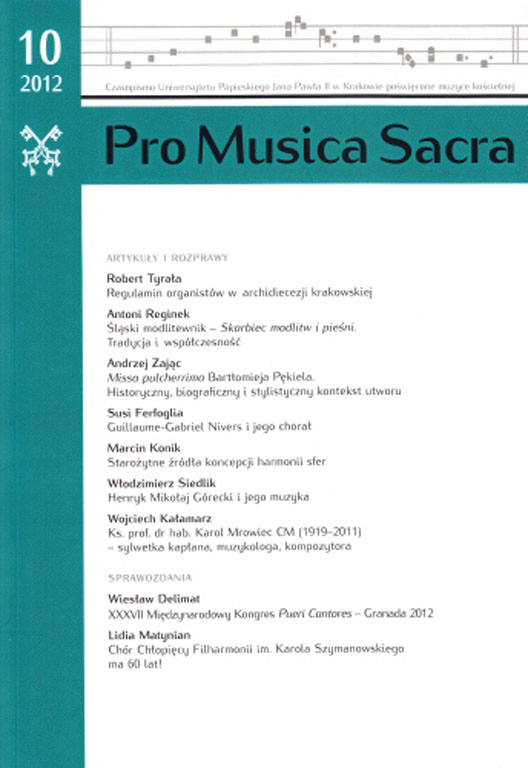„Missa pulcherrima” by Bartłomiej Pękiel. Historical, biographical and stylistic context of the composition
DOI:
https://doi.org/10.15633/pms.338Keywords:
Pękiel, the Royal Band, Sigismund III Vasa, Wladyslaw IV, the Swedish Deluge, the Wawel Cathedral Band, form of MassAbstract
The main aim of this study was to present the outstanding composition created by Bartłomiej Pękiela, Missa Pulcherrima, giving the historical, biographical, and stylistic context. The author succinctly depicted, first the historical background in which the composer lived and created, sketching the rulers of Poland of the time: Sigismund III, Vladislaus IV and John Casimir, against the important political events of the period. Having delivered the most up-to-date research, he carried on to a closer presentation of the composer himself, with a few biographical details, like these of his work as the Royal Choirmaster in Warsaw, and then the Cathedral Choirmaster at the Wawel Castle in Cracow. The author of this paper drew heavily on the studies made by eminent Polish musicologist, Rev. Hieronim Feicht (1894–1967), whose research on the biography and compositions of Bartłomiej Pękiel has not be rivaled so far by anything equally insightful and exhaustive. This study is an attempt to show Pękiel’s Missa Pulcherrima in the context of mass service compositions, proving that in its extraordinary composing and stylistic values it definitely differs from the other mass pieces by this composer written in the old style (stile antico). The said composition was created after 1655, when Pękiel moved from Warsaw to Cracow so as to undertake the position of the Cathedral Choirmaster at the Wawel Castle. Most probably, it was his last composition. A liable review of Bartłomiej Pekiel’s Missa Pulcherrima was rendered by expert in the Old Polish Music, Ewa Obniska: “Without doubt, it is the most outstanding old Polish mass, the stunning composition of outstanding artistry and unparalleled subtlety of melodic side […] the most tremendous religious masterpiece of the Polish Baroque – amongst those few which have lost nothing of their influential power despite centuries passing”.Downloads
Published
2012-12-30
Issue
Section
Artykuły i rozprawy
License
Copyright (c) 2012 Andrzej Zając

This work is licensed under a Creative Commons Attribution 4.0 International License.
Authors who publish with this journal agree to the following terms:
- Authors retain the copyright and full publishing rights without restrictions, and grant the journal right of first publication with the work simultaneously licensed under a Creative Commons Attribution 4.0 International License that allows others to share the work with an acknowledgement of the work's authorship and initial publication in this journal.
- Authors are able to enter into separate, additional contractual arrangements for the non-exclusive distribution of the journal's published version of the work (e.g., post it to an institutional repository or publish it in a book), with an acknowledgement of its initial publication in this journal.
- Authors are permitted and encouraged to post their work online (e.g., in institutional repositories or on their website) prior to and during the submission process, as it can lead to productive exchanges, as well as earlier and greater citation of published work (See The Effect of Open Access).

